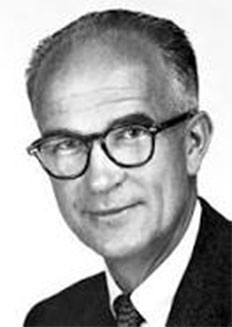William B. Shockley, Creator of Transistor and Theory on Race
Wolfgang Saxon

Wlliam Bradford Shockley, who shared a Nobel Prize in physics for his role in the creation of the transistor and earned the enmity of many for his views on the genetic differences between the races, died of cancer of the prostate at his home in California on August 14, 1989. He was 79 years old and lived on the campus of Stanford University.
He was a professor emeritus of electrical engineering at Stanford. In addition, he lectured and wrote extensively. Many of his early endeavors became clouded by controversy, however, because of his pronouncements on race. He preached a philosophy of ''retrogressive evolution.'' Stipulating that intelligence was genetically transmitted, he deemed blacks genetically inferior to whites and unable to achieve their intellectual level. As a corollary, he suggested that blacks were reproducing faster than whites - hence, the retrogression in human evolution.
Start of Electronic Age
In 1947, he and two colleagues from Bell Telephone Laboratories, the research arm of American Telephone & Telegraph Company, produced their first semiconductor device. And in 1956 he shared the Nobel Prize with the two, John Bardeen and Walter H. Brattain.
The invention of the transistor became the basis for the electronic age. From it flowed virtually every one of today's devices installed in airliners and cars, calculators and computers, wristwatches and washing machines.
Dr. Shockley left Bell Laboratories in 1954 and founded a semiconductor factory. A rebellion among his employees, who set up their own companies, began the phenomenon near Stanford University known as Silicon Valley.
Dr. Shockley went on to lecture at Stanford in 1958 and served as Alexander M. Poniatoff professor of electrical engineering and applied sciences from 1963 to 1975.
Debate on I.Q. Tests
His theory on racial differences set off a national argument over the use and applicability of I.Q. tests. Evidence that blacks tend to score lower than whites was discounted by most experts who saw the explanation in cultural and social rather than genetic terms.
Stanford University, which announced the death late yesterday, said Dr. Shockley regarded his work on race more important than his discovery of the transistor. Quoting his wife, the announcement said he continued to sift data and prepare papers on it until a few days before he died.
Dr. Shockley had alienated many of his fellow scientists by straying far beyond his ken. He drew further scorn when he proposed financial rewards for the ''genetically disadvantaged'' if they volunteered for sterilization.
He sued The Atlanta Constitution for a 1980 column likening that suggestion to Nazi experiments in genetic engineering. In 1984 a Federal jury in Atlanta found that he had been libeled but awarded him just $1 in actual damages.
Dr. Shockley had also raised some eyebrows when, at the age of 68, he contributed ''more than once'' to a California sperm bank mired in controversy for a project offering to pass along the genes of ''geniuses.''
William Bradford Shockley was born in London on Feb. 13, 1910, the grandson of a whaling captain and son of a consulting mining engineer.
He grew up in Palo Alto, not far from the Stanford campus. He received his bachelor's degree from the California Institute of Technology and earned a Ph.D. in physics from the Massachusetts Institute of Technology in 1936. He then went to work for Bell Laboratories in Murray Hill, N.J.
In World War II, Dr. Shockley directed the Navy's research on antisubmarine operations and returned to Bell Laboratories in 1945 as director of solid-state physics research.
His mission was to find a more reliable and smaller semiconductor to replace the classic vacuum-tube amplifier introduced by Lee De Forest in Palo Alto in 1907. The amplifier was the basic tool in radio and most other electronics.
Trial and Error
The team of Dr. Shockley, Dr. Brattain and Dr. Bardeen started out with the concept of the tubeless radio and proceeded from there by trial and error or, as Dr. Shockley later put it, by ''creative-failure methodology.''
''A basic truth that the history of the creation of the transistor reveals,'' he said, ''is that the foundations of transistor electronics were created by making errors and following hunches that failed to give what was expected.''
The team eventually chose silicon and germanium for their semiconductor and, in a rush of discoveries, reached the breakthroughs and successes that produced Dr. Shockley's ''magic month'' of 1947.
The devices, called transistors because they transferred current across a resistor, were built into a telephone, a radio and a television unit that Bell used in making the public introduction at a press conference in June 1948.
In addition to his wife, the former Emmy Lanning, Dr. Shockley is survived by three children from a previous marriage, William, Richard and Alison Ianelli, and one granddaughter.
Stanford University said no services are planned.
http://www.nytimes.com/learning/general/onthisday/bday/0213.html

